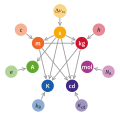International System of Units
International System of Units (SI) is the modern form of the metric system and is the most widely used system of measurement. It comprises a coherent system of units of measurement built on seven base units, which are the second, meter, kilogram, ampere, kelvin, mole, and candela.
History[edit]
The International System of Units was developed from the metric system at the General Conference on Weights and Measures (CGPM) in 1960. The conference recognized the need for a single, coherent system of units that could be used worldwide. The SI system was designed to be as simple and consistent as possible, and to be applicable to all fields of science and technology.
Base Units[edit]
The SI system is based on seven base units, which are the second (s), meter (m), kilogram (kg), ampere (A), kelvin (K), mole (mol), and candela (cd). These units are defined in terms of constants of nature and are intended to be as stable and reproducible as possible.
Derived Units[edit]
In addition to the base units, the SI system includes a number of derived units, which are formed by combining the base units according to the rules of algebra. Examples of derived units include the newton (N), which is a unit of force, and the joule (J), which is a unit of energy.
Symbols and Prefixes[edit]
Each unit in the SI system has a symbol, and these symbols are used in combination with prefixes to indicate multiples and submultiples of the units. For example, the prefix kilo- (k) indicates a multiple of 1000, so a kilometer is 1000 meters.
See Also[edit]
References[edit]
- Bureau International des Poids et Mesures (2019). The International System of Units (SI) (9th ed.). ISBN 978-92-822-2272-0.
|
|
|
-
SI Base Units and Constants
-
Physics Measurements in SI Units
-
Acceleration due to Gravity
-
Silicon Sphere for Avogadro Project
-
Metric and Imperial Systems
-
International System of Units
-
US National Length Meter
-
Unit Relations in the New SI
-
Cube Litre
Ad. Transform your life with W8MD's Budget GLP-1 injections from $75


W8MD offers a medical weight loss program to lose weight in Philadelphia. Our physician-supervised medical weight loss provides:
- Weight loss injections in NYC (generic and brand names):
- Zepbound / Mounjaro, Wegovy / Ozempic, Saxenda
- Most insurances accepted or discounted self-pay rates. We will obtain insurance prior authorizations if needed.
- Generic GLP1 weight loss injections from $75 for the starting dose.
- Also offer prescription weight loss medications including Phentermine, Qsymia, Diethylpropion, Contrave etc.
NYC weight loss doctor appointmentsNYC weight loss doctor appointments
Start your NYC weight loss journey today at our NYC medical weight loss and Philadelphia medical weight loss clinics.
- Call 718-946-5500 to lose weight in NYC or for medical weight loss in Philadelphia 215-676-2334.
- Tags:NYC medical weight loss, Philadelphia lose weight Zepbound NYC, Budget GLP1 weight loss injections, Wegovy Philadelphia, Wegovy NYC, Philadelphia medical weight loss, Brookly weight loss and Wegovy NYC
|
WikiMD's Wellness Encyclopedia |
| Let Food Be Thy Medicine Medicine Thy Food - Hippocrates |
Medical Disclaimer: WikiMD is not a substitute for professional medical advice. The information on WikiMD is provided as an information resource only, may be incorrect, outdated or misleading, and is not to be used or relied on for any diagnostic or treatment purposes. Please consult your health care provider before making any healthcare decisions or for guidance about a specific medical condition. WikiMD expressly disclaims responsibility, and shall have no liability, for any damages, loss, injury, or liability whatsoever suffered as a result of your reliance on the information contained in this site. By visiting this site you agree to the foregoing terms and conditions, which may from time to time be changed or supplemented by WikiMD. If you do not agree to the foregoing terms and conditions, you should not enter or use this site. See full disclaimer.
Credits:Most images are courtesy of Wikimedia commons, and templates, categories Wikipedia, licensed under CC BY SA or similar.
Translate this page: - East Asian
中文,
日本,
한국어,
South Asian
हिन्दी,
தமிழ்,
తెలుగు,
Urdu,
ಕನ್ನಡ,
Southeast Asian
Indonesian,
Vietnamese,
Thai,
မြန်မာဘာသာ,
বাংলা
European
español,
Deutsch,
français,
Greek,
português do Brasil,
polski,
română,
русский,
Nederlands,
norsk,
svenska,
suomi,
Italian
Middle Eastern & African
عربى,
Turkish,
Persian,
Hebrew,
Afrikaans,
isiZulu,
Kiswahili,
Other
Bulgarian,
Hungarian,
Czech,
Swedish,
മലയാളം,
मराठी,
ਪੰਜਾਬੀ,
ગુજરાતી,
Portuguese,
Ukrainian










